Many nations have installed significant solar power capacity into their electrical grids to supplement or provide an alternative to conventional energy sources. Solar power plants use one of two technologies:

Solar power in Germany consists almost exclusively of photovoltaics (PV) and accounted for an estimated 6.2 to 6.9 percent of the country's net-electricity generation in 2016. About 1.5 million photovoltaic systems were installed around the country in 2014, ranging from small rooftop systems, to medium commercial and large utility-scale solar parks. Germany's largest solar farms are located in Meuro, Neuhardenberg, and Templin with capacities over 100 MW. Solar heating does not use solar energy for power generation and is therefore not included in this article.
In Honduras, there is an important potential of untapped indigenous renewable energy resources. Due to the variability of high oil prices and declining renewable infrastructure costs, such resources could be developed at competitive prices.

As required by the Constitution, the electricity sector is federally owned, with the Federal Electricity Commission essentially controlling the whole sector; private participation and foreign companies are allowed to operate in the country only through specific service contracts. Attempts to reform the sector have traditionally faced strong political and social resistance in Mexico, where subsidies for residential consumers absorb substantial fiscal resources.

The Moura Photovoltaic Power Station is a large photovoltaic power station in Amareleja, in the municipality of Moura, Portugal. It is one of the largest power stations of its kind, and is built in one of the sunniest regions in Europe. Its construction involved two stages: stage 1 was completed in 2008 after 13 months, and stage 2 was completed in 2010. The entire project topped a total cost of €250 million.
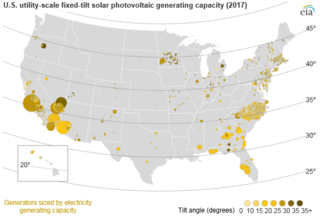
Solar power in the United States includes utility-scale solar power plants as well as local distributed generation, mostly from rooftop photovoltaics. As of the end of 2017, the United States had over 50 gigawatts (GW) of installed photovoltaic capacity. In the twelve months through May 2018, utility scale and distributed solar power generated 58.9 terawatt-hours (TWh), 1.44% of total U.S. electricity. During the same time period total solar generation, including estimated distributed solar photovoltaic generation, was 85.4 TWh, 2.09% of total U.S. electricity. In terms of total cumulative installed capacity, by year end 2017 the United States ranked 2nd in the world behind China. In 2016, 39% of all new electricity generation capacity in the country came from solar, more than any other source and ahead of natural gas (29%). By 2015, solar employment had overtaken oil and gas as well as coal employment in the United States. In 2016, more than 260,000 Americans were employed in the solar industry.
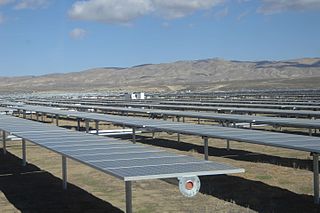
The California Valley Solar Ranch (CVSR) is a 250 megawatt (MWAC) photovoltaic power plant in the Carrizo Plain, northeast of California Valley. The project is owned by NRG Energy, and SunPower is the EPC contractor and technology provider. The project constructed on 1,966 acres (796 ha) of a 4,365-acre (1,766 ha) site of former grazing land. It is utilizing high-efficiency, crystalline PV panels designed and manufactured by SunPower. The project includes up to 88,000 SunPower solar tracking devices to hold PV panels that will track the sun across the sky.

Solar power in California includes utility-scale solar power plants as well as local distributed generation, mostly from rooftop photovoltaics. It has been growing rapidly because of high insolation, community support, declining solar costs, and a Renewable Portfolio Standard which requires that 33% of California's electricity come from renewable resources by 2020, and 50% by 2030. Much of this is expected to come from solar power via photovoltaic facilities or solar thermal power facilities.

The energy sector in Hawaii has rapidly adopted solar power due to the high costs of electricity, and good solar resources, and has one of the highest per capita rates of solar power in the United States. Hawaii's imported energy costs, mostly for imported petroleum and coal, are three times higher, and will soon be close to four times higher than the mainland, so Hawaii has motivation to become one of the highest users of solar energy. Hawaii was the first state in the United States to reach grid parity for photovoltaics. Its tropical location provides abundant sun energy.

The Copper Mountain Solar Facility is a 552 megawatt (MWAC) solar photovoltaic power plant in Boulder City, Nevada developed by Sempra Generation. It uses approximately 9 million cadmium telluride modules made by the US thin-film manufacturer First Solar. When the first unit of the facility entered service on December 1, 2010, it was the largest photovoltaic plant in the U.S. at 58 MW. It is co-located with the 64 MW Nevada Solar One and 150 MW Boulder Solar projects in the Eldorado Valley, thus forming a more than 750 MW solar generating complex. By comparison, generating capacity at the nearby Hoover Dam is about 2,000 MW.
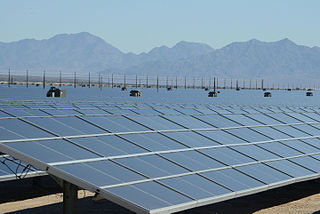
The Desert Sunlight Solar Farm is a 550 megawatt (MWAC) photovoltaic power station approximately six miles north of Desert Center, California, in the Mojave Desert. It uses approximately 8.8 million cadmium telluride modules made by the US thin-film manufacturer First Solar. As of Fall 2015, the Solar Farm has the same 550 MW installed capacity as the Topaz Solar Farm in the Carrizo Plain region of Central California, making both of them tied for the second largest completed solar plants by installed capacity.

A photovoltaic power station, also known as a solar park, is a large-scale photovoltaic system designed for the supply of merchant power into the electricity grid. They are differentiated from most building-mounted and other decentralised solar power applications because they supply power at the utility level, rather than to a local user or users. They are sometimes also referred to as solar farms or solar ranches, especially when sited in agricultural areas. The generic expression utility-scale solar is sometimes used to describe this type of project.

The 32 MW AC Long Island Solar Farm (LISF), located in Upton, New York, is the largest photovoltaic array in the eastern U.S. The LISF is made up of 164,312 solar panels from BP Solar which provide enough electricity for roughly 4,500 households. The project will cause the abatement of more than 30,000 metric tons of carbon dioxide emissions per year. LISF is co-owned by BP Solar and MetLife through Long Island Solar Farm LLC. Municipal utility Long Island Power Authority (LIPA) buys the 37-megawatt power plant's output, which is estimated at 44 GWh annually, under a 20-year power purchase agreement (PPA). Payments over that time are expected to total $298 million. The project was engineered by Blue Oak Energy and construction subcontracted to Hawkeye LLC from Hauppauge, New York. The plant earned the Best Photovoltaic Project of Year Award from the New York Solar Energy Industries Association. The panels are mounted at a fixed tilt angle of 35°, with the rows spaced approximately 18 ft 4 in (5.59 m) apart.
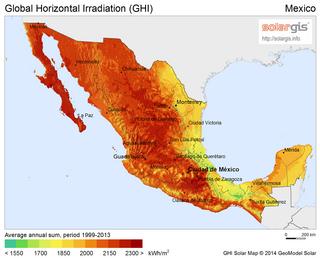
Solar power in Mexico has the potential to produce vast amounts of energy. 70% of the country has an insolation of greater than 4.5 kWh/m²/day. Using 15% efficient photovoltaics, a square 25 km (16 mi) on each side in the state of Chihuahua or the Sonoran Desert could supply all of Mexico's electricity.

Solar power in Florida has been increasing, as the cost of solar power systems using photovoltaics (PV) has decreased in recent years. Florida has low electricity costs compared with other states, which makes individual solar investment less attractive. Florida ranks ninth nationally in solar resource strength according to the National Renewable Energy Laboratory and tenth in solar generation by the Solar Energy Industries Association.

Solar power in South Africa includes photovoltaics (PV) as well as concentrated solar power (CSP). In 2016, South Africa had 1,329 MW of installed solar power capacity. Installed capacity is expected to reach 8,400 MW by 2030.
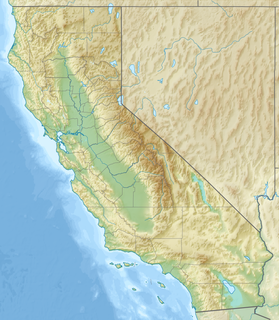
The Westlands Solar Park is a planned, large-scale solar power project in Kings County south of Fresno, California. It intends to build a large number of photovoltaic power plants with a capacity totaling upwards of 2,000 megawatts (MW), larger than the world's largest photovoltaic power plants operating as of 2017. It will be constructed on brownfield land owned by the Westlands Water District that is unusable for agriculture due to excess salt pollution.

Mount Signal Solar, also known as Imperial Valley Solar Project, is a 594 MWp (460 MWAC) photovoltaic power station west of Calexico, California in the southern Imperial Valley, near the Mexican border. The facility is being developed and constructed by 8minutenergy Renewables in three phases, with two completed as of 2018. At full build-out, it will be one of the world's largest PV solar farms with a capacity of about 800 MWp (600 MWAC). The project has been supported by several environmental groups, as the power station was built on low productivity farmland.

The Springbok Solar Farm is a 328 MWp (260 MWAC) photovoltaic power station in the northwestern Mojave Desert, near California City in eastern Kern County, California. The facility is being developed and constructed by 8minutenergy Renewables in three phases, with two completed as of 2016. At full build-out, it will be one of the world's largest PV solar farms with a capacity of about 440 MWp (350 MWAC).

The CIAL Solar Power Project is a 40 megawatt (MW) photovoltaic power station built at COK airport, India, by the company Cochin International Airport Limited (CIAL). Cochin International Airport became the first fully solar powered airport in the world with the commissioning the plant.
















